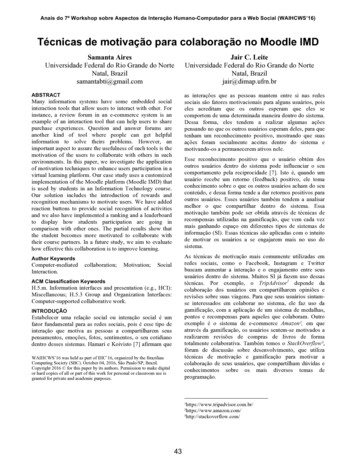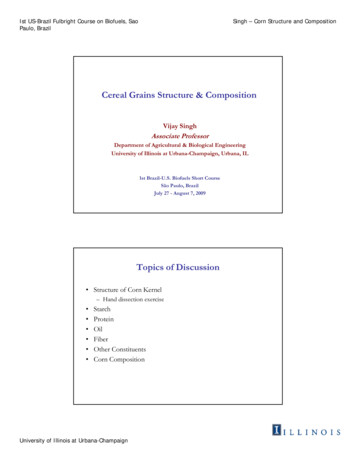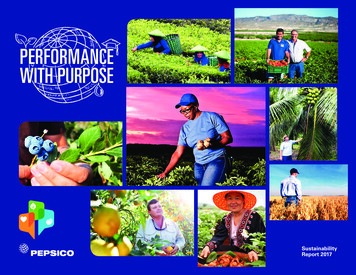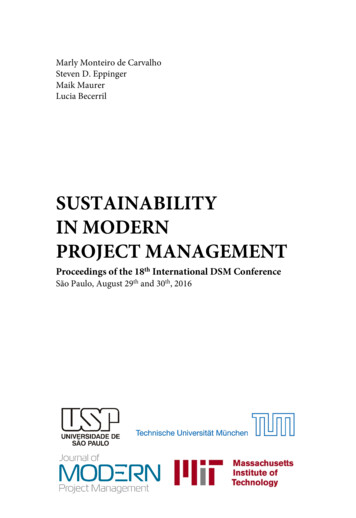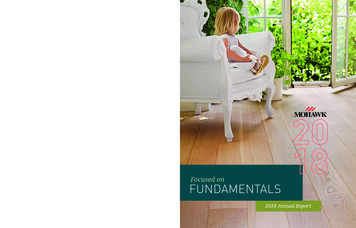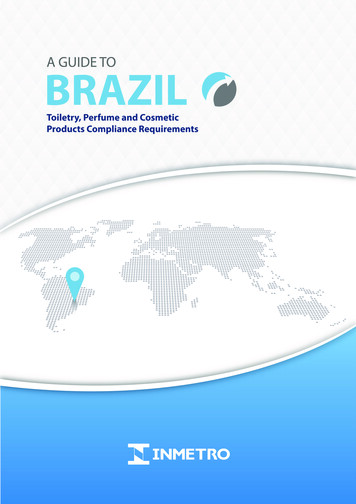
Transcription
A Guide to Brazil Toiletry, Perfume and Cosmetic Products Compliance Requirements1
Instituto Nacional de Metrologia, Qualidade e Tecnologia (Inmetro)PresidenteCarlos Augusto de AzevedoCoordenador Geral de Articulação Internacional (Caint)Jorge Antônio da Paz CruzChefe da Divisão de Superação de Barreiras Técnicas (Disbt)Léa Contier de FreitasEdição e organização Reinaldo Wacha (Divisão de Superação de Barreiras Técnicas)Projeto gráfico e diagramação Petronio Fonseca (Divisão de Comunicação Social do Inmetro)Instituto Nacional de Metrologia, Qualidade e Tecnologia - InmetroCoordenação de Articulação Internacional - CaintRua Santa Alexandrina, 416 - 9º andarCEP: 20261-232 - Rio de Janeiro, brOuvidoria Inmetro: 0800 285 1818Todos os direitos reservados pelo Instituto Nacional de Metrologia, Qualidade e Tecnologia (Inmetro). Ostextos contidos nesta publicação poderão ser reproduzidos, armazenados ou transmitidos, desde que citada a fonte.Edição publicada em 09/05/2017.A Guide to Brazil Toiletry, Perfume and Cosmetic Products Compliance Requirements2
IndexOverview 04How To Use This Guide 04Scope 04The regulatory framework in Brazil 05Regulation of Toiletries, Perfumes and Cosmetics08Federal Regulatory Authorities and Technical Regulations (Mandatory)09Regulatory Authority of Toiletries, Perfumes and Cosmetics09Brazillian Health Regulatory Agency – Anvisa09Anvisa’s Product Market Authorization Process09National Institute of Metrology, Quality and Technology – Inmetro14Other authorities / relevant laws 14Standards Developing Organization 14Testing laboratories 15ILAC Accredited Testing Laboratories 15Government stakeholders – contact information 15Main Market Entity 16Appendix I - Regulations 17Anvisa Regulations 17Inmetro Regulations 19Appendix II - Standards 20Appendix III - Testing Laboratories relevant to the Scope21Testing laboratories accredited by ILAC member (Inmetro)21A Guide to Brazil Toiletry, Perfume and Cosmetic Products Compliance Requirements3
OverviewThis guide does not intend to exhaust the subject, but was created in order to facilitatethe export of Toiletries, Perfumes and Cosmetics to Brazil. It shows the regulatory authorities, main requirements/laws that need to be taken into account, conformity assessmentprocedures and government bodies, ministries, departments or any authority involved inthe process.All the documents mentioned in this guide are applied to the scope. Regulations are considered mandatory while Standards, on the other hand, are voluntary unless “Incorporated by Reference” in a regulation.The responsibility for updating the documents (Regulations/Standards) cited in this guiderests with the Regulation Authorities / Standardization Bodies. Therefore it is recommended that the version of any document is always checked through the corresponding website. The Brazilian Enquiry Point could also provide more information through the e-mailbarreirastecnicas@inmetro.gov.br.How To Use This Guide Regulations are mandatory Standards are voluntary (unless “Incorporated by Reference” in a regulation) Guidelines may be voluntary (but are often de facto industry standards)ScopeThis guide addresses the compliance requirements for Toiletries, Perfumes and Cosmetics.The National Health Surveillance Agency (Anvisa) defines those products as preparationsof natural or synthetic substances, for external use on diverse parts of the human body,skin, hair, nails, lips, external genital organs, teeth, and mucous membranes of the oralcavity, with the sole or main objective of cleaning them, perfume them, alter their appearance and/or correct body odors, and protect and maintain them in good shape. Accordingto Resolution RDC 7/2015, products can be classified under group 1 or group 2, dependingon whether proof of their basic properties, safety and effectiveness and detailed information on use and on restrictions are necessary or not. Products that fall typically undergroup 1 include, among others, skin moisturizers (without sunscreen; except those forstretch marks), face cleansing creams, lotions, gels and oils (except those for acne skin),perfumes, lipsticks (without sunscreen), fingernail polishes, eye and facial makeup preparations (without sunscreen), eyelash mascara, cleansing shampoos and hair conditionersA Guide to Brazil Toiletry, Perfume and Cosmetic Products Compliance Requirements4
(except those antidandruff, for hair loss prevention or that claim other benefit), bathsalts, oils, gel capsules and foam, facial or body soap (except those with antiseptic action),deodorants (except those antiperspirants), toothpastes (except those containing fluoride;for prevention of dental plaque or tooth decay; indicated for sensitive teeth; chemicalbleachers) . The mentioned exceptions fall under group 2, as well as hydrogen peroxide10 to 40 volumes (including creamy products, except those for medicinal use); children’sproducts,; sunscreen lotions and creams; products for straightening, curling and/or dyeinghair; products for wrinkles; antiseptic soap; insect repellent products, among others.The regulatory framework in BrazilA large number of agencies at federal level (regulatory agencies) have the authority toprepare technical regulations in a specific competence area. Technical regulations arealways published in the Official Journal and, in general, are based on international standards. The agencies may start the preparation of a technical regulation ex officio or at therequest of a third part. If the competent authority considers it necessary, a draft regulationis developed and published in the Official Journal, after an impact evaluation assessmentof the new technical regulation. Technical regulations take the form of laws, decrees, resolutions and ordinances etc. Brazil normally allows a period of at least six months betweenthe publication and their entry into force in order to enable interested parties to becomeacquainted with them.Public audiences or hearings are also a way to promote public consultation on technicalregulations. In parallel, if the technical regulation is considered to have effects on trade,it is notified to WTO to allow Members to make comments in writing.Instituto Nacional de Metrologia, Qualidade e Tecnologia – InmetroThe National Institute of Metrology, Quality and Technology (Inmetro) is the Brazilian Enquiry Point responsible for submitting to the WTO the notification of draft technical regulations under the TBT Agreement. The technical regulation projects that have an impacton international trade are notified, even if those regulations are identical to internationalstandards. It should be noted that the vast majority of Brazilian technical regulations arebased on international standards and product performance criteria. In addition to its regulations and conformity assessment procedures, Inmetro notify to WTO technical requirements of other government agencies, such as the National Health Surveillance Agency(Anvisa), Ministry of Agriculture, Livestock and Supply (Mapa) the National PetroleumAgency (ANP), the Ministry of Mines and Energy (MME), the National TelecommunicationsAgency (Anatel), among others.A Guide to Brazil Toiletry, Perfume and Cosmetic Products Compliance Requirements5
Inmetro is responsible for receiving comments from other countries on draft regulations.Both domestic and foreign private sectors can make comments and participate in thediscussions. After all comments and suggestions are analyzed, the specific competenceagency decides whether to adopt the technical regulation, taking into account or not thecomments/suggestions received.In 2007, Brazil adopted The Brazilian Guide on Good Regulatory Practices , to help preparing, review, revoke, and disseminate technical regulations. This encourages transparencyand consistency on the improvement of regulatory practices. The Guide recommends thatpublic bodies focus on safety, health, environment and consumer protection issues. Thereis not, however, mandatory rules of general application for drawing up technical regulations. Each entity is responsible for the development of technical regulations based ontheir own procedures.Inmetro and all other regulatory bodies can develop and adopt assessment conformityprocedures. The process by which conformity assessment programs are carried out is similar to that used in the case of technical regulations. There is a period of public consultationand the measure is published in the Official Journal. Conformity assessment proceduresthat carry considerable economic impact are also notified to the WTO by Inmetro.Based on the specific characteristics of the product, conformity assessment can be performed by certification, labeling, inspection, sampling and/or a supplier’s declarationof conformity. Certification is performed by third parties, in general accredited privatebodies. Products and services subject to mandatory certification are those that can affecthealth and consumer safety or the environment.Inmetro recognizes the certification of products and systems carried by foreign productcertification bodies (OCP) which have a memorandum of understanding with a BrazilianOCP or with which Inmetro has signed an agreement. Furthermore, Inmetro is the national authority for the accreditation of certification, inspection and training bodies andcalibration and testing laboratories.It is worth explaining that the National Institute of Metrology, Standardization and Industrial Quality (Inmetro) is a federal agency under the Ministry of Industry, Trade andServices, which acts as the Executive Secretariat of the National Council of Metrology,Standardization and Industrial Quality (Conmetro), an interministerial collegiate, which isthe regulatory body of the National System of Metrology, Standardization and Industrial Quality (Sinmetro). Sinmetro, Conmetro and Inmetro make up an articulated systemicstructure, created by Law 5.966 of December 11, 1973. On the occasion Inmetro replacedthe then existing National Institute of Weights and Measures (INPM) and, with the new legal responsibilities, increased significantly its field of action, always in service of Braziliansociety. Main information on Inmetro can be obtained at www.inmetro.gov.br.A Guide to Brazil Toiletry, Perfume and Cosmetic Products Compliance Requirements6
Agência Nacional de Vigilância Sanitária – AnvisaThe Brazilian Health Regulatory Agency (Anvisa), an agency under the Ministry of Health,was established by Law no. 9782 of January 26, 1999. It aims at promoting and protectingthe population’s health through the sanitary control of production and consumption ofgoods and services subject to health surveillance, including the environment, processes,inputs and technologies related to them, as well as the control of ports, airports, bordercrossings and customs enclosures. Main information about Anvisa can be obtained in theirwebsite: http://portal.anvisa.gov.br/.Associação Brasileira de Normas Técnicas – ABNTThe body responsible for developing voluntary technical standards in Brazil is the BrazilianAssociation of Technical Standards (ABNT), a non-profit, non-governmental body that receives financial support from the Federal Government, founded in 1940. ABNT representsBrazil in the International Organization for Standardization (ISO), the International Electrotechnical Commission (IEC) and regional standardization forums such as the Pan American Standards Commission (COPANT) and MERCOSUR Standardization Association (AMN).The Brazilian standards development process follows the WTO good practice code in orderto guarantee transparency.In order to ensure that the content of the rules is up to date, standards older than fiveyears are reviewed. The review process follows international guidelines and includes public consultation through the ABNT website. During the consultation period, interestedparties have the opportunity to express an opinion to whether the standard should beconfirmed, updated or canceled. Main information on ABNT can be obtained at www.abnt.org.br.Associação Brasileira da Indústria de Higiene Pessoal, Perfumaria e Cosméticos – ABIHPECThe Brazilian Association of the Toiletry, Perfume and Cosmetics Industry (ABIHPEC) wascreated in 1995 as the natural evolution of an association from the State of São Paulo,founded in 1941. It brings together around 400 companies of different sizes, which correspond to 94% of the sector’s turnover. Main information on APIHPEC can be obtained athttps://abihpec.org.br/.ABIHPEC plays an important sectorial role within ABNT. In 2004, ABIHPEC installed ABNTcommittee/CB-57 – Toiletry, Perfumery and Cosmetics to address industry standards including products, processes, services and raw materials concerning terminology, requirements,classification and test methods, best practices and other generalities. CB-57 is the officialA Guide to Brazil Toiletry, Perfume and Cosmetic Products Compliance Requirements7
national standardization forum for the toiletries, perfumery and cosmetics industry, according to award granted by Resolution no. 7 of August, 24 1992, of the National Councilof Metrology, Standardization and Industrial Quality (Conmetro). CB-57 participates inthe ISO committee TC 217, which covers HPPC products, initially as an Observer Member,in 2004, and as a Participant Member, as from August 1, 2011.Regulation of Toiletries, Perfumes and CosmeticsThe Ministry of Health controls the manufacture and import of all Toiletries, Perfumesand Cosmetics in Brazil since the publication of Law no. 6.360 of September 23, 1976 andits Decree no. 79.094 of January 5, 1977, revoked by Decree no. 8077 of August 14, 2013.The intention is to ensure the safety and product quality for the population’s health protection.The Brazillian Health Regulatory Agency (Anvisa) is the main authority and responsiblefor documents in the scope. Their Department of Cosmetics, under the Directorate ofCoordination of the National Health Surveillance System (DSNVS), address all pre-marketregulation matters concerning toiletries, cosmetics and perfumes and also those relatingto raw materials, labeling and technological innovations of such products. Authorizationof the operation of manufacturers and importers and post-market matters at national level, including compliance, enforcement and cosmetovigilance are under the responsibilityof Directorate of Health Control and Monitoring (DIMON), which acts in conjunction withthe state and municipal health surveillance secretariats.Brazil is a MERCOSUR Member State and most of the health requirements for Toiletries,Perfumes and Cosmetics (Higiene Pessoal, Perfumes e Cosméticos, HPPC, in Portuguese)products are harmonized and recognized by MERCOSUR regulations since 2004. It is Important to mention that MERCOSUR resolutions enter into force after being internalizedthrough national mechanisms and published in the Official Journal of each Member State.Also in compliance with Law Nº 6.360/76, only companies authorized by the Ministry ofHealth and licensed by the Health Agency of the Federal States where they are located canextract, produce, manufacture, process, synthesize, purify fraction, pack, repack, import,export, store or ship cosmetics in Brazil.A Guide to Brazil Toiletry, Perfume and Cosmetic Products Compliance Requirements8
Federal Regulatory Authorities and Technical Regulations (Mandatory)AgencyScopeBrazillian Health Regulatory Agency (Anvisa)Toiletries, Perfumes and Cosmetics sanitary regulation including: authorization of the operation ofmanufacturers and importers; good manufacturingpractices; marketing authorization, post-marketsanitary control and sanitary border control.National Institute of Metrology, Quality and Technology (Inmetro)Product safety, children’s products, cosmetic packaging and labeling relating to weight and volume,unfair trade practices and product performance.Brazilian Customs (Receita Federal Brasileira)Border control and country of origin (for most imported products, licensing, and certification).The Chief of Staff of the Presidency of the Republic(Casa Civil da Presidência da República)Consumer Law.Regulatory Authority of Toiletries, Perfumes and CosmeticsBrazillian Health Regulatory Agency – AnvisaA list of documents published by Anvisa can be found in the Appendix I of this guide orcan be viewed directly in the Anvisa database through the link http://portal2.saude.gov.br/saudelegis/LEG NORMA PESQ CONSULTA.CFM.Anvisa’s Product Market Authorization ProcessOverviewThere are two ways for Toiletries, Perfumes and Cosmetics to be authorized at BrazilianMarket: registration and prior notification of a product exempted of registration.Registration is the legal act that recognizes the suitability of a product to sanitary legislation, granted by the Brazillian Health Regulatory Agency – Anvisa. It is a control appliedprior to commercialization of products that could present higher health risks. After reviewing the dossier, the Agency publicizes the awarded registration in the Official Journal(Diario Oficial da União - DOU) as proof of the concession by Anvisa. After this, the product is authorized to be sold in Brazil.Prior notification of a product exempted of registration is the administrative procedureto be applied to inform Anvisa of the intention to commercialize a product exemptedA Guide to Brazil Toiletry, Perfume and Cosmetic Products Compliance Requirements9
from registration by means of electronic communication. About 97% of the Toiletries,Perfumes and Cosmetics products that have the commercialization authorized in Brazilfollow this route.To have Market Authorization, products subject to health surveillance, must comply withthe criteria laid down by Brazilian laws and with the specific regulations established byAnvisa. These criteria aim at minimizing possible risks associated with the product in question.The manufacturer or importer company is responsible for the quality and safety of theproducts authorized by Anvisa.Regulation involvedAnvisa’s Toiletries, Perfumes and Cosmetics Technical Regulation RDC nº 07/2015 is thedocument that lays down the general product characteristics and technical requirements.It can be accessed through link /29327, andother specific regulation can be accessed through link http://portal.anvisa.gov.br/legislacao#.ScopeOnly Products listed in Annex VIII of Technical Regulation RDC 07/2015, are subject to theAnvisa registration procedure. They are: sunscreen and suntan lotions, children’s products,hair straighteners, insect repellents and antiseptic gels for the hands.These Products have specific indications, whose characteristics require proof of safety and/or efficacy , as well as information on care, mode and restrictions of use.Process flowchart for registrationThe registration must be requested by the interested company through the PetitioningSystem ento), following the steps below:STEP 1 - Company RegistrationThe Company Registration is the first step to have access to the Petitioning System andshould be used to register private companies that provide products or services regulatedby Anvisa and to register the users with bond of representation with these companies.More information about de registration process can be obtained through the link (only inPortuguese) http://portal.anvisa.gov.br/cadastramento.A Guide to Brazil Toiletry, Perfume and Cosmetic Products Compliance Requirements10
STEP 2 - Change of the size of the company (optional)Anvisa calculates the fees applied to the process according to the size of the company.By default, Anvisa classify all companies as big size and, if it is not the case, it could bechanged in this step.More information about company size classification can be obtained through the link(only in Portuguese) http://portal.anvisa.gov.br/porte-de-empresa.STEP 3 - RequestBefore accessing the Requesting System it is recommended that the interested party identify the Subject Code ssuntos) related totheir request, since the entire request process will be developed under this code.During the process, the interested party will be driven to the type of petition of the chosen Subject Code.More information about de Request can be obtained through the link (only in nto.STEP 4 - FeesAt the end of the petition process, a payment document (Guia de Recolhimento da União- GRU) will be electronically generated so that the taxes related to the process (Taxa deFiscalização de Vigilância Sanitária - TFVS) can be covered. The corresponding fee is determined by Interministerial Ordinance Nº. 701, 31 August, 2015 or its updated versions.More information about fees can be obtained through the link (only in Portuguese) http://portal.anvisa.gov.br/taxas1.STEP 5 – Document protocolAfter payment of the GRU, the interested party must gather the documentation requested according to the checklist of the chosen Subject Code and send to Anvisa, containingthe following address (only original documents are accepted):À Agência Nacional de Vigilância SanitáriaAos cuidados da Gerência de Gestão DocumentalRef: (Process Number)SIA, trecho 5, área especial 57CEP 71.205-050Brasília – DF, BrasilA Guide to Brazil Toiletry, Perfume and Cosmetic Products Compliance Requirements11
More information about document protocol can be obtained through the link (only inPortuguese) http://portal.anvisa.gov.br/protocolo.Documents required by the processThe documents required by the process are listed in the checklist of the Subject Code. Processes will be rejected if documents are missing or filled wrongly.How to follow the processProgress of the request can be followed by checking Document Status in the system,through the link -documentos1.More information on how to follow the process can be obtained through the link (only inPortuguese) http://portal.anvisa.gov.br/acompanhamento.How to know the resultPublication of the awarded registration in the Official Journal (Diario Oficial da União DOU) represents proof of the concession by Anvisa. After this, the product is authorizedto be sold in Brazil.The Brazilian Official Journal (DOU) can be accessed through the link http://portal.imprensanacional.gov.br/.The product must, necessarily, correspond to what was evaluated and authorized by Anvisa, according to the registration process protocol. Furthermore, no change is allowedwithout prior authorization of Anvisa, as established in art. 13 of the Law Nº 6360/1976.Anvisa may, at any time and in its discretion, require additional evidence or tests in casethat new events raise concerns about the product, even after granting its registration.Validity of the processRegistration is valid for five years from the date of publication in the Official Journal(DOU).Process flowchart for prior notification of a product exempted of registrationThe prior notification of a product exempted of registration must be requested by theinterested company through two systems: (1) the Petitioning System and (2) System for notification of Toiletries, Perfumes and Cosmetics exempted of registration – SGAS following thesteps below:A Guide to Brazil Toiletry, Perfume and Cosmetic Products Compliance Requirements12
STEP 1 - Company RegistrationThe Company Registration is the first step to have access to the Petitioning System andshould be used to register private companies that provide products or services regulatedby Anvisa and to register the users with bond of representation with these companies.More information about de registration process can be obtained through the link (only inPortuguese) http://portal.anvisa.gov.br/cadastramento.STEP 2 - Change of the size of the company (optional)Anvisa calculates the fees applied to the process according to the size of the company.By default, Anvisa classify all companies as big size and, if it is not the case, it could bechanged in this step.More information about company size classification can be obtained through the link(only in Portuguese) http://portal.anvisa.gov.br/porte-de-empresa.STEP 3 – RequestFrom this point the notification of a product exempt from registration must be made inSystem for notification of Toiletries, Perfumes and Cosmetics exempted of registration –SGAS following the steps required at the system.STEP 4 - FeesAt the end of the petition process, a payment document (Guia de Recolhimento da União- GRU) will be electronically generated so that the taxes related to the process (Taxa deFiscalização de Vigilância Sanitária - TFVS) can be covered. The corresponding fee is determined by Interministerial Ordinance Nº 701, 31 August, 2015 or its updated versions.More information about fees can be obtained through the link (only in Portuguese) http://portal.anvisa.gov.br/taxas1.How to follow the processProgress of the request can be followed in SGAS system itself.How to know the resultAfter processing the payment, the notification of the product will be publicized on Anvisa s website through the link ioExterno/consultaExterna.xhtml. Hereafter, the product is authorized to be sold in Brazil.The product must, necessarily, correspond to what was notified to Anvisa.Anvisa may, at any time and in its discretion, requires additional evidence or tests in caseA Guide to Brazil Toiletry, Perfume and Cosmetic Products Compliance Requirements13
that new events raise concerns about the product, even after granting its registration.Validity of the processNotification is valid for five years from the date of publication in Anvisa’s website.National Institute of Metrology, Quality and Technology – InmetroInmetro, through their Conformity Assessment Directorate, can regulate this scope if requested by Anvisa. Main information about Inmetro can be obtained at the website: http://www.inmetro.gov.br. Statement of weight and volume in pre-packaged products is alsoregulated by Inmetro, since it is a legal metrological requirement.A list of documents published by Inmetro can be found in the Appendix I of this guide orcan be viewed directly in the Inmetro database through the link seq classe 1&sig classe RTAC.Other authorities/relevant lawsInternal Revenue Service (Customs) - Receita Federal (Aduana)National Authority responsible for the control of import documents and taxes.Website: http://idg.receita.fazenda.gov.brThe Chief of Staff of the Presidency of the Republic - Casa Civil da Presidência da RepúblicaThe Consumer Law defines mandatory requirements applied to all commercial relation inBrazil.Standards Developing OrganizationThe Brazilian Official Standards responsible is the ABNT and a list of standards related tothe scope can be found in the Appendix II of this guide or can be viewed directly in theABNT database through the link http://www.abntcatalogo.com.br.Note: Full text of Standards is not available for free.A Guide to Brazil Toiletry, Perfume and Cosmetic Products Compliance Requirements14
Testing laboratoriesThe conformity assessment process requires laboratories accredited by an ILAC memberas Inmetro.ILAC Accredited Testing LaboratoriesInmetro is an ILAC member and the Brazilian official accreditation body. All the laboratories accredited by Inmetro are so according to ILAC criteria and has international recognition, according to the ILAC MRA, as explained in the footnote.A list of accredited laboratories by Inmetro can be found in Appendix III or can be vieweddirectly in the Inmetro database through the link (only in Portuguese) nment stakeholders – contact informationBrazilian Health Regulatory AgencyAgência Nacional de Vigilância Sanitária – ANVISASetor de Indústria e Abastecimento (SIA) - Trecho 5, Área Especial 5771205-050Brasília, DF, BrasilTel: (55) 61 448.1078Fax: (55) 61 448.1089E-mail: rel@anvisa.gov.brWebsite: http://portal.anvisa.gov.brInstituto Nacional de Metrologia, Qualidade e Tecnologia – INMETRORua Santa Alexandrina, 416 - Rio Comprido20.261-232 Rio de Janeiro, RJ, BrasilTel: (55) 21 2563.2840Fax: (55) 21 2563.5637Email: barreirastecnicas@inmetro.gov.brWebsite: http://www.inmetro.gov.br/A Guide to Brazil Toiletry, Perfume and Cosmetic Products Compliance Requirements15
Ministério da Indústria, Comércio e Serviços – MDICEsplanada dos Ministérios, Bloco “J”,70.053-900 Brasília, DF, BrasilTel: 55 (61) 2027-7000Website: http://www.mdic.gov.br/Ministry of Justice and Citizenship – Ministério da Justiça e CidadaniaDepartment of Consumer Protection - Departamento de Proteção e Defesa do Consumidor (DPDC)Esplanada dos Ministérios, Bloco “T”, sala 52070064-900Brasília, DF, BrasilTel: 55 (61) 2025-3105Website: http://www.mj.gov.br/senaconAssociação Brasileira de Normas Técnicas – ABNTRua Conselheiro Nébias, 1.131, Campos Elíseos01203-002São Paulo, SP, BrasilTel: 55 (11) 3017-3645/ 3646Website: http://www.abnt.org.br/Main Market EntityAssociação Brasileira da Indústria de Higiene Pessoal, Perfumaria e Cosméticos - ABIHPECAv. Paulista, 1313, 10º andar, conjunto 1080, Bela Vista01311-923São Paulo, SP, BrasilTel: 55 (11) 3372-9899Fax: 55 (11) 3266-5387Website: https://www.abihpec.org.br/A Guide to Brazil Toiletry, Perfume and Cosmetic Products Compliance Requirements16
Appendix I - RegulationsAnvisa RegulationsLaw 6360/1976 - Regulates the health surveillance to which Medicines, Drugs, Pharmaceuti-cal Drugs and Related, Cosmetics, Sanitizing and Other Products are subject and give otherprovisio
May 31, 2017 · A Guide to Brazil Toiletry, Perfume and Cosmetic Products Compliance Requirements 4 Overview This guide does not intend to exhaust the subject, but was created in order to facilitate the export of Toiletries, Perfumes

